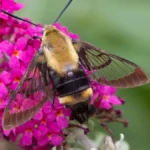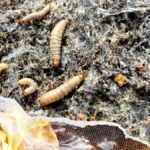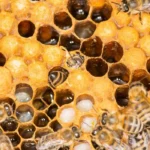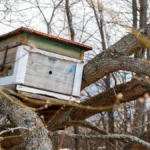Wax moths are irritating pests of beehives that can cause damage to stored frames, and can sometimes damage actual hives. Wax moths traps allow you to reduce the number of wax moths in an area and reduce damage to your hives and beekeeping equipment. In this article, we look at a few homemade and bought wax moth trap options that you can employ in your beekeeping.
What Are Wax Moths?
Wax moths are an irritating pest that can damage weak beehives. In the honey house, wax moths often cause terrible problems by getting into supers and stored combs and turning them into a mess of wax month silk and feces. We took an in-depth look at wax moths here.
A short summary is that these moths will find combs containing pollen or bee silk. Bee silk is left behind after the brood metamorphosizes and emerges from a cell. The bee silk is edible for the wax moth larvae and provides them with protein and nutrients. The larvae burrow through the combs making a terrible mess.
In weak hives, the wax moths can attack combs that are not covered by bees and can damage these as well. This can sometimes irritate the bees so much that they leave, or die. As a beekeeper, arriving to find your hive has been reduced to a tangled web of silk is very depressing.
How To Trap Or Kill Wax Moths
We have a number of different options to use which can control and reduce wax moth populations. There are a few simple things we can do in the honey house to reduce wax moth numbers. These range from traps, to electric insect killers to fumigants. Controlling wax moths in beehives is best done with traps. There are some products that can be inserted in hives, which poison the larvae or the adults – my personal opinion is that these are unnecessary as external traps can control the situation. There are numerous wax moth strips impregnated with pesticides that are promoted. Why introduce additional poisons into a hive if we do not need them?
Wax Moths Trap
Trapping wax moths is relatively easy – they are not very clever insects and are easily attracted to liquid bait. When they enter the bait container, they drown in the bait. There is a certain satisfaction to finding a wax moth trap full of dead moths. When I used to make these, we could not buy them online. Hence I will go through the DIY method I used, and then later review the ready-bought products you can buy. Both basically do the same thing.
DIY Homemade Moth Traps
My simplest and most effective method was as follows:
Take a large empty PET cooldrink bottle. Make sure it has a lid. Drill a 3/4 to a 1-inch hole about three inches down from the lid. Drill another hole on the other side of the bottle. Take a small drill bit to make a hole through the lid and run a wire through this hole.
Take a funnel and place it in one of the holes you have drilled. While the funnel is dry pour a cup of brown sugar through the funnel. You may need to use a skewer to get the sugar through the funnel. Pour a cup of live cloudy cider vinegar into the bottle. Then mix a tablespoon of honey into a cup of water and pour this through the funnel. If you have a little bit of comb or capping wax, put this into the mix. Swirl the bottle to mix everything. If you take some banana peels and chop these up into slivers you can throw them into the mix.
Fermentation
Everything will begin to ferment and get a sweet-sour smell that is attractive to wax moths. After a day or two, you can hang this contraption wherever you wish to trap wax moths. It will fill up with wax moths and all manner of other insects in a few weeks. I normally just take the whole bottle, cut the lid off and throw the mix into my chicken cage – the chickens love the pickled insects.
You will need to replace these two or three times over a season. I typically just put three of these per apiaries of 20-30 hives, but I see that other beekeepers recommend one for every three to four hives. I guess it is a test and see what works for your method.
Purchased Moth Traps
If you do not have the time or inclination to make a trap then you can buy this trap. Use the same recipe as above. Given the smaller volume of the trap mix externally and fill the traps. With these traps, you can just unscrew the lid and empty out moths and hornets into a bucket every few weeks, replenish the bait and take the bucket of insect slops back to your chickens. Or chuck it in the bin.
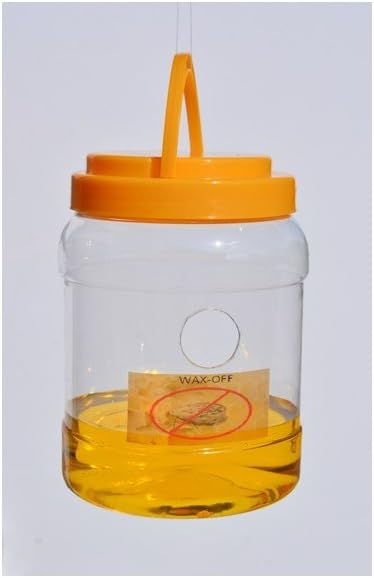
Controlling Wax Moths In The Honey House and Stored Supers
Controlling wax moths in the honey house is a different story from controlling them in the hives. Bees can defend a hive quite well against wax moths – unprotected supers are a different story.
Electric insect zapper in the honey house
In my honey house, I used to have a decent-sized electric insect trap such as this one. These traps are incredibly useful as they will kill all manner of problem insects in the honey house ranging from flies, wax moths, hive beetles to stray bees that can become a robbing problem.

It is a good idea to put a reminder on your phone to clean the bottom of the trap at least twice a month – they fill up with insects and if there are a lot of bees you can end up with these creating small fires.
Control Of Wax Moths In Supers and Stored Brood Boxes
There are chemical and non-chemical methods you can use to control wax moths in stored brood and super boxes. My preference is always to go with non-chemical interventions first, and if these are not able to control the situation, then use chemical means.
Freezing
If you place stacks of supers in airtight bags and seal them, then freeze the bags. I have friends who have used this method for many years with great effect. You need to freeze the boxes for long enough to get the entire mass of supers to below 5°F. I have seen a few reports suggesting at least two hours. At the operation, I worked at it was better to do this overnight.
Wax Moth Fumigant
There is some debate around the use of so-called Para crystals. These are currently still legal in the US and can be sourced here. Follow the usage instructions carefully. This is a nasty chemical as is evident in the warnings and medical advice section.
Biological Control
I am always a fan of using nature to control things. Bacillus thuringiensis (Bt) is a bacterium that is quite diverse. Certain strains of this bacterium kill caterpillar larvae and in this regard, there has been recent development of a BT control for the wax moths. You can read more about it here.
I have not tried this specific product yet, but have used BT formulations to treat other caterpillar problems in my garden. BT is very effective.
I hope this article has helped you understand more about wax moths traps and how to make your own or buy appropriate solutions for your apiary. In my opinion, the most important control is in your honey house, and if your bees are strong and well managed the wax moth should be of little worry in the apiary. But being a bit careful and putting a few traps out here and there always helps, especially in poor years when the bees are stressed. If you enjoyed this article please share.
Read more about: Moth That Looks Like A Bee
Beehive Wax Moth Trap FAQs
What are wax moths, and why are they harmful to beehives?
Wax moths are pests that infest weak beehives, feeding on bee silk and pollen in the comb. Their larvae burrow through the hive, causing significant damage, especially to stored comb and frames.
How do wax moth traps work?
Wax moth traps lure moths using a sweet-sour bait mixture, such as vinegar, brown sugar, honey, and banana peels. Once moths enter the trap, they become trapped and eventually drown in the bait.
Can I make my own wax moth trap at home?
Yes! DIY wax moth traps can be made using a simple PET bottle, sugar, vinegar, honey, and other ingredients. The fermentation of these ingredients attracts the moths, making this method effective and budget-friendly.
What is the best location to place wax moth traps in an apiary?
Place traps near weak hives, stored supers, and honey houses where wax moths are most likely to be present. Hanging traps around apiaries with 20-30 hives or placing them near specific trouble spots is recommended.
How often should I replace the bait in wax moth traps?
The bait should be replaced every few weeks or once the trap is full of moths and other insects. You’ll notice decreased effectiveness if the bait becomes too diluted or the moths start decomposing.
Can wax moths be controlled without using chemicals?
Yes! Non-chemical methods like traps, electric zappers in honey houses, and freezing stored brood boxes can effectively manage wax moths without the need for chemicals.
Is it necessary to use fumigants to control wax moth infestations?
Fumigants should only be used as a last resort when non-chemical methods are insufficient. Alternatives like freezing supers or using biological controls, such as Bacillus thuringiensis (Bt), are often effective.
How does freezing stored supers prevent wax moth infestations?
Freezing kills wax moth larvae and eggs. By placing supers in sealed bags and freezing them below 5°F (-15°C) for several hours or overnight, you can effectively prevent infestation.
What types of electric insect traps can help control wax moths?
Electric zappers are useful in honey houses to kill flying insects, including wax moths, flies, and small hive beetles. Regularly clean the trap to avoid buildup and ensure consistent effectiveness.
Can I prevent wax moths without using traps or chemicals?
Strong, well-managed hives are naturally resistant to wax moth infestations. Ensuring healthy colonies and proper hive maintenance, combined with occasional traps, can greatly reduce the risk of wax moth damage.

Dr. Garth A. Cambray is a Canadian/South African entrepreneur and beekeeper with 28 years of experience in apiculture and specializes in adding value to honey. His Ph.D. research developed a new advanced continuous fermentation method for making mead that has resulted in a number of companies globally being able to access markets for mead. His company, Makana Meadery, exports honey mead to the USA where it is available to discerning connoisseurs. He has also developed technologies to commercially manufacture organic honey vinegar in Zambia for export globally. He holds a few patents globally in the ethanol industry and believes in technology and knowledge transfer for human development and environmental sustainability. One of his proudest achievements is the fact that the wind farm he started at one of his old apiary sites has essentially made his hometown carbon neutral.

